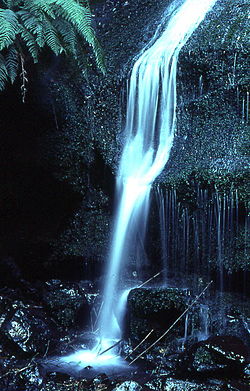Mount Wilson, New South Wales
| Mount Wilson Federal division(s) | Macquarie | ||||||||||||||
|---|---|---|---|---|---|---|---|---|---|---|---|---|---|---|---|
| |||||||||||||||
| Mount Wilson | |
|---|---|
 Tributary to Waterfall Creek, Waterfall Reserve | |
| Highest point | |
| Elevation | 1,008 m (3,307 ft) |
| Parent peak | Bell Range |
| Coordinates | 33°31′S 150°22′E / 33.517°S 150.367°E[2] |
| Geography | |
| Location | Blue Mountains, New South Wales, Australia |
Mount Wilson is a village in the
Description
Mount Wilson is a long, low mountain formation that sprawls for 5 kilometres (3.1 mi) in the northern Blue Mountains area. It is completely surrounded by the Blue Mountains National Park, a World Heritage Area. It has been partly developed as a residential area, with elaborate gardens that have become a tourist attraction. The area is particularly popular in the autumn when the red and orange leaves give it extra colour. According to some, the "well-organised locals have managed to resist the tidal wave of development which swept through the other mountain towns."[3]

History
The Mount Wilson area was surveyed in 1868 by Edward Wyndham. It was subsequently named after
The novelist Patrick White spent some of his youth there, writing about the place in his 1981 memoir Flaws in the Glass; his parents had lived in Mount Wilson between 1912 and 1937. In Flaws in the Glass, he referred to "one of those tedious Australian, would-be tourists attractions called Chinaman's Hat," a reference to a local rock formation.[6]
Heritage listings
Mount Wilson has a number of heritage-listed sites, including:
- 68-78 The Avenue: Wynstay Estate[7]
Activities
Apart from visiting the gardens for which the area is famous, it is also possible to do a number of walks in places like Waterfall Reserve, the rainforest pocket in Davies Lane, the Cathedral of Ferns, Pheasants Cave, Chinamans Hat and, for more experienced walkers, the track to the Wollangambe River.
-
Withycombe, built by George Henry Cox
-
Cathedral of Ferns
-
St George's Church
See also
References
- ^ a b Australian Bureau of Statistics (28 June 2022). "Mount Wilson". 2021 Census QuickStats. Retrieved 21 September 2022.
- ^ "Mount Wilson (mountain)". Geographical Names Register (GNR) of NSW. Geographical Names Board of New South Wales. Retrieved 12 May 2015.
- ^ Smith, Jim (1986). How to See The Blue Mountains. Second Back Row Press. p. 31.
- ^ "Mount Wilson (village)". Geographical Names Register (GNR) of NSW. Geographical Names Board of New South Wales. Retrieved 2 November 2009.
- ^ Hungerford; Donald (1982). Exploring the Blue Mountains. Kangaroo Press. pp. 172–173.
- ^ White, Patrick (1981). Flaws in the Glass. Jonathan Cape.
- .
- ^ Paton, Neil (2004). Sydney and Blue Mountains Bushwalks. Kangaroo Press. pp. 291–298.
External links
- Mount Wilson Website
- Mt Wilson to Bilpin Bush Run - held each August
- Article about Mount Wilson in the Sydney Morning Herald
- Ian Jack (2008). "Mount Wilson". Dictionary of Sydney. Retrieved 28 September 2015. [CC-By-SA]




